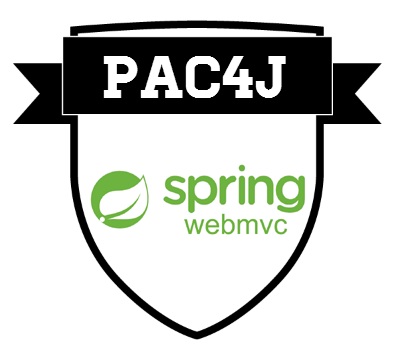The spring-webmvc-pac4j project is an easy and powerful security library for Spring Web MVC / Spring Boot web applications and web services. It supports authentication and authorization, but also logout and advanced features like session fixation and CSRF protection.
It's based on the pac4j security engine. It's available under the Apache 2 license.
| spring-webmvc-pac4j | JDK | pac4j | Spring | Usage of Lombok | Status |
|---|---|---|---|---|---|
| version >= 8 | 17 | v6 | v6 | Yes | In development |
| version >= 7 | 17 | v5 | v6 | No | Production ready |
| version >= 5 | 11 | v5 | v5 | No | Production ready |
| version >= 4 | 8 | v4 | v5 | No | Production ready |
- A client represents an authentication mechanism. It performs the login process and returns a user profile. An indirect client is for web application authentication while a direct client is for web services authentication:
▸ OAuth - SAML - CAS - OpenID Connect - HTTP - Google App Engine - LDAP - SQL - JWT - MongoDB - CouchDB - Kerberos - IP address - Kerberos (SPNEGO) - REST API
- An authorizer is meant to check authorizations on the authenticated user profile(s) or on the current web context:
▸ Roles - Anonymous / remember-me / (fully) authenticated - Profile type, attribute - CORS - CSRF - Security headers - IP address, HTTP method
-
A matcher defines whether the
SecurityInterceptormust be applied and can be used for additional web processing -
The
SecurityInterceptorprotects an url by checking that the user is authenticated and that the authorizations are valid, according to the clients and authorizers configuration. If the user is not authenticated, it performs authentication for direct clients or starts the login process for indirect clients -
The
CallbackControllerfinishes the login process for an indirect client -
The
LogoutControllerlogs out the user from the application and triggers the logout at the identity provider level -
The
JEEContextand theProfileManagercomponents can be injected -
The
@RequireAnyRoleand@RequireAllRolesannotations check the user roles.
Usage
1) Add the required dependencies
2) Define:
- the security configuration
- the callback configuration, only for web applications
- the logout configuration
3) Apply security
4) Get the authenticated user profiles
Demos
The demo webapps for Spring Web MVC without Spring Boot: spring-webmvc-pac4j-demo or with Spring Boot: spring-webmvc-pac4j-boot-demo are available for tests and implement many authentication mechanisms: Facebook, Twitter, form, basic auth, CAS, SAML, OpenID Connect, JWT...
Versions
The latest released version is the , available in the Maven central repository.
The next version is under development.
See the release notes. Learn more by browsing the pac4j documentation and the spring-webmvc-pac4j Javadoc.
See the migration guide as well.
Need help?
You can use the mailing lists or the commercial support.
